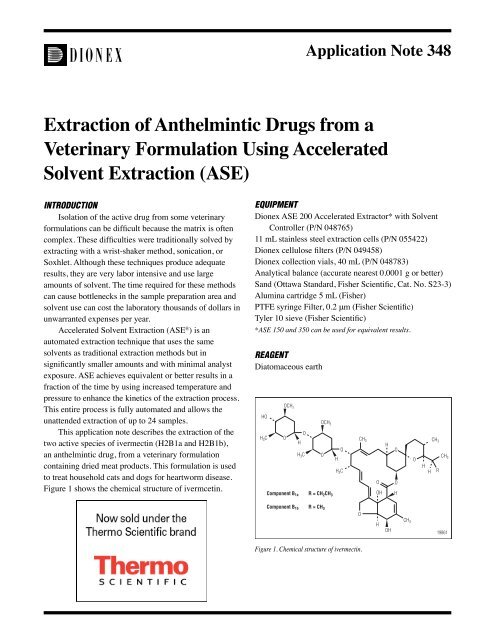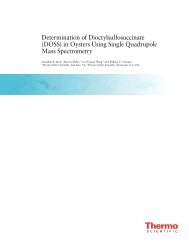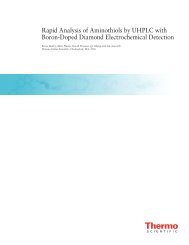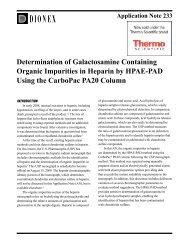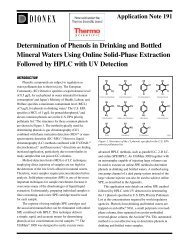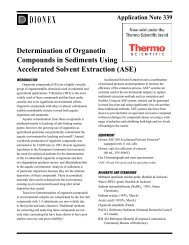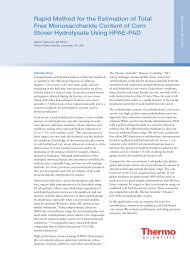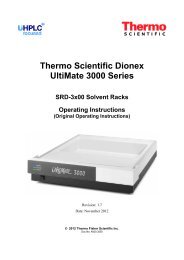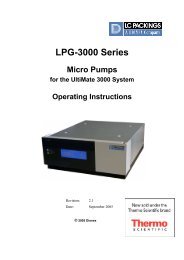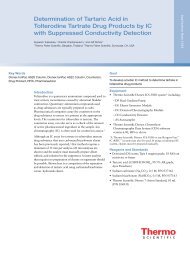AN 348:Extraction of Anthelmintic Drugs from a Veterinary ... - Dionex
AN 348:Extraction of Anthelmintic Drugs from a Veterinary ... - Dionex
AN 348:Extraction of Anthelmintic Drugs from a Veterinary ... - Dionex
Create successful ePaper yourself
Turn your PDF publications into a flip-book with our unique Google optimized e-Paper software.
Application Note <strong>348</strong><br />
<strong>Extraction</strong> <strong>of</strong> <strong>Anthelmintic</strong> <strong>Drugs</strong> <strong>from</strong> a<br />
<strong>Veterinary</strong> Formulation Using Accelerated<br />
Solvent <strong>Extraction</strong> (ASE)<br />
Introduction<br />
Isolation <strong>of</strong> the active drug <strong>from</strong> some veterinary<br />
formulations can be difficult because the matrix is <strong>of</strong>ten<br />
complex. These difficulties were traditionally solved by<br />
extracting with a wrist-shaker method, sonication, or<br />
Soxhlet. Although these techniques produce adequate<br />
results, they are very labor intensive and use large<br />
amounts <strong>of</strong> solvent. The time required for these methods<br />
can cause bottlenecks in the sample preparation area and<br />
solvent use can cost the laboratory thousands <strong>of</strong> dollars in<br />
unwarranted expenses per year.<br />
Accelerated Solvent <strong>Extraction</strong> (ASE ® ) is an<br />
automated extraction technique that uses the same<br />
solvents as traditional extraction methods but in<br />
significantly smaller amounts and with minimal analyst<br />
exposure. ASE achieves equivalent or better results in a<br />
fraction <strong>of</strong> the time by using increased temperature and<br />
pressure to enhance the kinetics <strong>of</strong> the extraction process.<br />
This entire process is fully automated and allows the<br />
unattended extraction <strong>of</strong> up to 24 samples.<br />
This application note describes the extraction <strong>of</strong> the<br />
two active species <strong>of</strong> ivermectin (H2B1a and H2B1b),<br />
an anthelmintic drug, <strong>from</strong> a veterinary formulation<br />
containing dried meat products. This formulation is used<br />
to treat household cats and dogs for heartworm disease.<br />
Figure 1 shows the chemical structure <strong>of</strong> ivermcetin.<br />
Equipment<br />
<strong>Dionex</strong> ASE 200 Accelerated Extractor* with Solvent<br />
Controller (P/N 048765)<br />
11 mL stainless steel extraction cells (P/N 055422)<br />
<strong>Dionex</strong> cellulose filters (P/N 049458)<br />
<strong>Dionex</strong> collection vials, 40 mL (P/N 048783)<br />
Analytical balance (accurate nearest 0.0001 g or better)<br />
Sand (Ottawa Standard, Fisher Scientific, Cat. No. S23-3)<br />
Alumina cartridge 5 mL (Fisher)<br />
PTFE syringe Filter, 0.2 μm (Fisher Scientific)<br />
Tyler 10 sieve (Fisher Scientific)<br />
*ASE 150 and 350 can be used for equivalent results.<br />
Reagent<br />
Diatomaceous earth<br />
HO<br />
H 3 C<br />
OCH 3<br />
OCH 3<br />
O<br />
O<br />
CH<br />
H<br />
3<br />
O<br />
H 3 C O<br />
H<br />
Component B 1a R = CH 2 CH 3<br />
H 3 C<br />
O<br />
OH<br />
H<br />
O<br />
O<br />
H<br />
O<br />
H<br />
H<br />
CH 3<br />
R<br />
CH 3<br />
Component B 1b R = CH 3<br />
O<br />
H<br />
OH<br />
CH 3<br />
19861<br />
Figure 1. Chemical structure <strong>of</strong> ivermectin.
Solvent<br />
Methanol<br />
Water<br />
(All solvents are pesticide-grade or equivalent and<br />
available <strong>from</strong> Fisher Scientific.)<br />
<strong>Extraction</strong> Conditions<br />
Solvent:<br />
95% methanol, 5% water<br />
Temperature: 120 °C<br />
Pressure: 1500 psi*<br />
Heatup time: 6 min<br />
Static time: 10 min<br />
Static cycles: 1<br />
Flush: 30%<br />
Purge:<br />
60 s<br />
*Pressure studies show that 1500 psi is the optimum extraction<br />
pressure for all ASE applications.<br />
Sample PREPARATION<br />
The tablet should be finely ground using a food<br />
processor or c<strong>of</strong>fee grinder to a powder that can<br />
pass through a Tyler 10 sieve. Accurately weigh out<br />
approximately 0.5–1.5 g <strong>of</strong> the powder and blend<br />
with 1.5 g <strong>of</strong> diatomaceous earth using a mortar and<br />
pestle. Transfer the mixture to an 11 mL stainless steel<br />
extraction cell containing a cellulose filter. Top <strong>of</strong>f any<br />
dead space in the cell with Ottawa sand. Prepare any<br />
other tablet samples and load them into extraction cells.<br />
<strong>Extraction</strong> Procedure<br />
Place the cells onto the ASE 200. Label the<br />
appropriate number <strong>of</strong> collection vials and place these<br />
into the carousel. Set up the method suggested above and<br />
begin the extraction. When the extraction is complete,<br />
the extract can then be diluted to the desired volume and<br />
passed through a 5 mL alumina cartridge. Finally, filter<br />
the extract into an HPLC vial through a 0.2 μm PFTE<br />
filter and analyze using HPLC. 1<br />
Results and Discussion<br />
Sample preparation is critical to good recoveries.<br />
Grind the samples to a uniform particle size to ensure<br />
proper permeation <strong>of</strong> the solvent into the matrix. The<br />
sample extracts may be somewhat cloudy due to the<br />
extractions <strong>of</strong> fats and other coextractables, so it is<br />
important to pass the extracts through a short column<br />
<strong>of</strong> alumina.<br />
Table 1 shows the results <strong>of</strong> extracting placebo<br />
preparations spiked with a varying range <strong>of</strong> ivermectin<br />
concentrations (50–150%). The average recovery for all<br />
concentration levels was 100.5%.<br />
Table 1. ASE Recovery <strong>of</strong> Ivermectin <strong>from</strong> Spiked<br />
Placebo Samples<br />
Target* % Set 1 Set 2 Set 3 Set 4 Mean % RSD<br />
50 98.4 103.9 97.3 100.0 99.9 2.9<br />
75 99.2 102.0 98.7 98.7 99.7 1.6<br />
100 102.3 99.9 100.4 100.6 100.8 1.0<br />
125 103.3 101.2 103.3 102.1 102.1 1.3<br />
150 100.9 98.2 99.6 100.1 100.1 1.6<br />
*Shows a range <strong>of</strong> 50–150% <strong>of</strong> the target concentration (0.9 μg/mL)<br />
Table 2 shows the precision <strong>of</strong> the ASE method.<br />
Six preparations <strong>from</strong> one lot <strong>of</strong> HEARTGARD ®<br />
Chewables for Cats were extracted and analyzed. The<br />
average percent recovery for these six preparations was<br />
102.3% with an RSD <strong>of</strong> 0.90%. These recovery and<br />
precision values are as good or better than observed with<br />
traditional extraction techniques.<br />
Table 2. ASE Method Precision Summary: <strong>Extraction</strong><br />
<strong>of</strong> Ivermectin <strong>from</strong> HEARTGARD Chewables for Cats<br />
Preparation<br />
% Recovery<br />
1 101.3<br />
2 103.5<br />
3 101.6<br />
4 102.4<br />
5 101.6<br />
6 103.2<br />
Mean 102.3<br />
% RSD 0.90<br />
2 <strong>Extraction</strong> <strong>of</strong> <strong>Anthelmintic</strong> <strong>Drugs</strong> <strong>from</strong> a <strong>Veterinary</strong> Formulation Using Accelerated Solvent <strong>Extraction</strong> (ASE)
Conclusion<br />
These results confirm that ASE is comparable to<br />
traditional extraction methods for the difficult extractions<br />
<strong>of</strong> active drugs <strong>from</strong> veterinary formulations. Traditional<br />
extraction methods usually take <strong>from</strong> one to several hours<br />
for each sample and require large amounts <strong>of</strong> solvent.<br />
With ASE, the extraction time is cut to approximately<br />
15 min per sample and uses only 25–30 mL <strong>of</strong> solvent.<br />
In addition, the ASE 200 can extract up to 24 samples,<br />
sequentially, without user intervention.<br />
ACKNOWLEDGEMENTS<br />
We would like to acknowledge the work <strong>of</strong> Andreas<br />
Abend and his colleagues at Merck & Co. Inc.<br />
REFERENCES<br />
1. Abend, A. M.; Chung L.; McCollum, D. G.;<br />
Wuelfing, W. P. “Development and Validation <strong>of</strong> an<br />
Automated <strong>Extraction</strong> Method (Accelerated Solvent<br />
<strong>Extraction</strong> ® ) and a Reverse-Phase HPLC Analysis<br />
Method for Assay <strong>of</strong> Ivermectin in a Meat-Based<br />
Chewable Formulation.” Pharm and Bio Med<br />
Analysis 2003, 31, 1177–1183.<br />
ASE is a registered trademarks <strong>of</strong> <strong>Dionex</strong> Corporation.<br />
HEARTGARD is a registered trademark <strong>of</strong> Merial.<br />
Speed • Simplicity • Solutions<br />
<strong>Dionex</strong> Corporation North America<br />
Europe<br />
Asia Pacific<br />
1228 Titan Way<br />
U.S./Canada (847) 295-7500 Austria (43) 1 616 51 25 Benelux (31) 20 683 9768; (32) 3 353 4294<br />
Australia (61) 2 9420 5233 China (852) 2428 3282 India (91) 22 2764 2735<br />
P.O. Box 3603<br />
Denmark (45) 36 36 90 90 France (33) 1 39 30 01 10 Germany (49) 6126 991 0 Japan (81) 6 6885 1213 Korea (82) 2 2653 2580 Singapore (65) 6289 1190<br />
South America<br />
Sunnyvale, CA<br />
Ireland (353) 1 644 0064 Italy (39) 02 51 62 1267 Sweden (46) 8 473 3380<br />
Taiwan (886) 2 8751 6655<br />
Brazil (55) 11 3731 5140<br />
94088-3603<br />
Switzerland (41) 62 205 9966 United Kingdom (44) 1276 691722<br />
LPN 1573-01 PDF 4/11<br />
(408) 737-0700 www.dionex.com Application Note ©2011 344 <strong>Dionex</strong> Corporation 3


